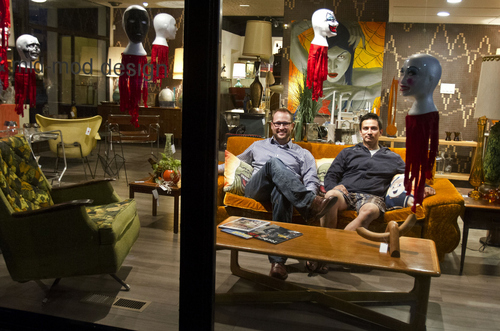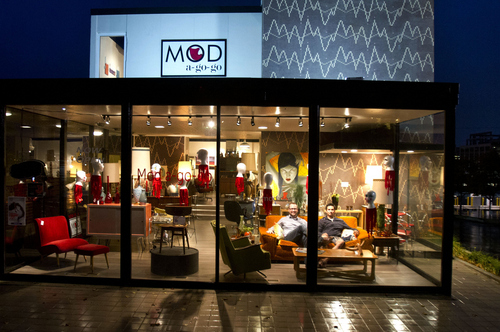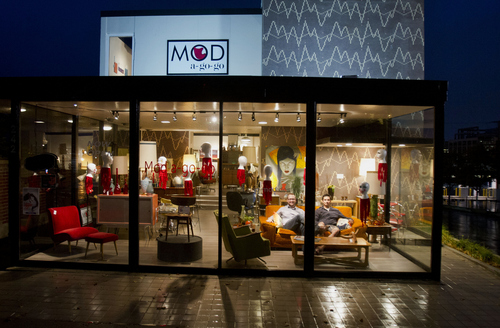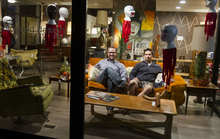This is an archived article that was published on sltrib.com in 2013, and information in the article may be outdated. It is provided only for personal research purposes and may not be reprinted.
Walk past Mod a-go-go's windowed storefront after hours and two truths seem hardly likely. First, that nobody is there. It is soft-lit, warm and inviting, and you half-expect a dapper ad man to walk in, newspaper in the crook of his arm, and settle cross-legged into an armchair. But the greater shock is that this lived-in feel was achieved in the past six months — as recently as May, the building was something of a blight on downtown Salt Lake City.
The owners of the consignment store at 242 E. South Temple leave the lights on after locking up, and that's no mistake. They want passersby to stop and gaze at their oversized diorama of midcentury executive life with a contemporary twist.
"I don't know how many people have said, 'Oh my gosh, I'm here because I was driving by last night and you are like the only lit building on this whole entire street,' " said co-owner Marcus Gibby, who has seen people hunch over and peer in, smudging the windows and wiping them off with shirt sleeves.
The inspiration for Mod a-go-go was a class taught by Westminster College Center for Entrepreneurship director Linda Muir, who challenged Eric Morley and three classmates to devise a business plan and contemplate how they'd take it to market. Morley knew from Gibby, his partner and a working artist, that the consignment scene often relegated local artists' work to the walls of coffee shops, soaking up steam as uninterested patrons gabbed about the weather. His idea was to create an environment — using midcentury furniture — that would complement the art.
The two began to work together. Gibby attended a Westminster lecture series with Morley, and speakers like Ruby Snap cookie maker Tami Cromer firmed their belief that a local businessperson with a good idea could carve out a niche. If they were careful.
"I've worked in risk management at American Express for 14 years, so I'm like the epitome of a risk-averse person," Morley says. "We really leveraged Westminster and what I learned through the MBA program to calculate every step."
They almost settled on a location a couple of blocks away, but the deal fell through and they were led to the former Kings Row Formal Wear building.
"Marcus always calls it our 'unicorn of buildings,' " Morley said. "It's that mythical creature that you always want to see but never actually get."
The interior was in disarray, and while they originally planned on a minimal renovation, landlord Price Realty encouraged them to "do it right," Gibby said, by subsidizing higher-end options that would truly revive the space. "We got really, really lucky. I'd like to take all the credit for it, and I'm sure Eric would, but we know that we couldn't have done it without them."
Muir praises the duo's use of "sweat equity" — getting friends and family to roll up their sleeves and help out. Mod a-go-go illustrates two principles she preaches to budding entrepreneurs: 1. Don't use all your capital to open, and 2. Look bigger than you are. Where Morley and Gibby did spend, they spent wisely. They sprung for lighting and a swanky sign. They took to no-cost social media to spread the word about the consignment store they birthed out of an old tailor's shop.
By the June opening — 30 minutes before which they were still hammering away — the buzz was such that 400 people turned out, including Muir. "I got to see it in the inception phase," she said. "It was pretty darn cool to see it come to life."
The downstairs replicates a '50s or '60s living area, with couches, peabody chairs, credenzas, stools and tables. The furniture is minimal, linear and generally raised off the floor. Nothing is stacked. Though the owners "gutted" most of the interior, they retained the building's hallmark '50s tile facade, which is the backdrop for half of the showroom.
Upstairs is a more traditional gallery space: unencumbered by furniture and with industrial rafters they can use to add pieces for gallery events. One frequent customer plans to have his wedding in the space later this month.
Morley and Gibby say they've tried to cultivate a positive relationship with the local art community. One of Mod a-go-go's best-selling artists, West Jordan resident Heather Ackley, says she does everything she can to hype the store on Facebook and to fellow artists at events like Craft Lake City because not only are they crack promoters, but their enthusiasm has rejuvenated her interest in showing her work downtown. "Since I've started working with them, I've gained an appreciation for Salt Lake City that I didn't have."
The owners recently hosted The Modern Chair competition, in which 22 artists submitted their best chair designs to a jury and 500 people turned out to watch Clayton Thompson win the top prize for his Oxbow chair. On Friday at 6 p.m., as part of the Salt Lake Gallery Stroll, they will present a Halloween Group Show with spooky offerings from local artists.
It's a busy life for the couple. Besides working 9 to 5 for American Express, Morley has three children from a previous marriage whom he sees on weekends (his 9-year-old and a friend have pitched a door-to-door antiques outfit they've dubbed "Mod a-lo-lo"). Gibby continues to paint and takes a full-time courseload at the University of Phoenix. The former fitness fanatics who met running at the gym three years ago now find little time for the treadmill.
They hope to hire some help, and think that if sales continue at the current pace, that will happen soon. For now, it's a two-man show — with a clear division of duties, Morley jokes.
"Marcus creates paintings, and the extent of my creativity is to do a mean Excel spreadsheet. But I don't think I'll ever frame one of those."
Twitter: @matthew_piper









